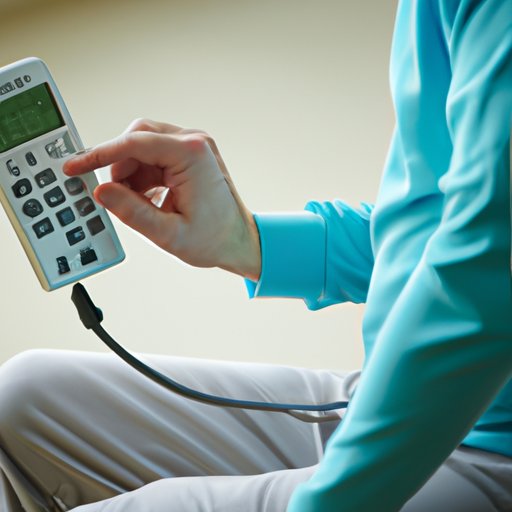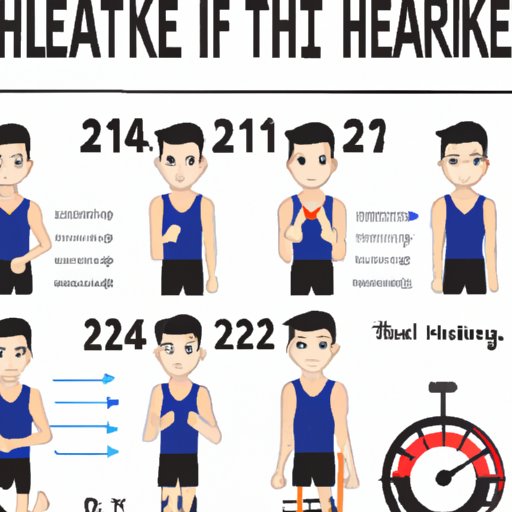Introduction
Knowing your normal heart rate when working out can help you maximize your workout and reach your fitness goals more quickly. This article will explore the recommended heart rate for exercise, how to calculate your target heart rate, and factors that affect your heart rate while working out. We’ll also look at the benefits of keeping your heart rate at an optimal level and provide tips for monitoring your heart rate during exercise.

Exploring the Recommended Heart Rate for Working Out
The American Heart Association (AHA) recommends exercising for at least 30 minutes per day, five days a week. During this time, it is important to maintain a healthy heart rate. The AHA states that “the intensity of physical activity should be moderate to vigorous, depending on individual capacity and health status.”
What is the Optimal Heart Rate During Exercise?
Your optimal heart rate while exercising is determined by your age and fitness level. To determine your maximum heart rate (MHR), subtract your age from 220. For example, if you are 40 years old, your MHR is 180 beats per minute (BPM). Your resting heart rate (RHR) is the number of times your heart beats per minute when you are at rest. This can be measured by taking your pulse for 10 seconds and multiplying it by 6.
Understanding Your Ideal Heart Rate When Exercising
Once you know your MHR and RHR, you can calculate your target heart rate (THR). This is the range of heart rates that you should aim for when exercising. Your THR is typically 50-85% of your MHR. For example, if your MHR is 180 BPM, your THR would be 90-153 BPM. It’s important to note that these numbers are just general guidelines and may vary based on your fitness level and other factors.

Calculating Your Target Heart Rate for Maximum Benefit
When calculating your THR, there are several factors to consider. Your level of fitness is one of the most important factors. If you’re new to exercise, it’s best to start with a lower intensity workout and gradually increase the intensity as your fitness level improves. Another factor to consider is your age. As you get older, your MHR decreases and your THR should be adjusted accordingly. Other factors such as medications, health conditions, and gender can also play a role in determining your THR.
A Guide to Knowing Your Normal Heart Rate While Working Out
Monitoring your heart rate during exercise is the best way to ensure that you’re in the right heart rate zone. You can use a heart rate monitor or take your pulse manually. If you’re using a heart rate monitor, make sure that it’s set to the correct settings for your age and fitness level. If you’re taking your pulse manually, count your pulse for 10 seconds and multiply by 6. Here are some tips for staying in the right heart rate zone:
- Start with a warm-up period of 5-10 minutes to allow your heart rate to gradually increase.
- Check your heart rate every 5-10 minutes during your workout.
- Make sure to cool down for 5-10 minutes after your workout.
- Take breaks when needed to keep your heart rate from going too high.

Maximizing Your Workout with Optimal Heart Rate Levels
Keeping your heart rate at an optimal level while exercising has many benefits. According to a study published in the journal Medicine & Science in Sports & Exercise, “participants who exercised at higher intensities had significantly greater cardiovascular and metabolic responses than those who exercised at lower intensities.” This means that exercising at the right intensity can help you burn more calories and improve your overall fitness level.
In addition, exercising at the right intensity can help you increase your endurance and improve your performance. When you exercise at a higher intensity, your body has to work harder and this can help you build strength and stamina over time.
Conclusion
In conclusion, understanding your normal heart rate when working out is essential for maximizing your workout and reaching your fitness goals. Knowing your MHR and RHR can help you calculate your THR and stay in the right heart rate zone during exercise. Keeping your heart rate at an optimal level can help you burn more calories, improve your fitness level, and increase your endurance. By monitoring your heart rate and making adjustments as needed, you can ensure that you’re getting the most out of your workouts.
Final Thoughts
Staying active is an important part of leading a healthy lifestyle. Knowing your normal heart rate when working out can help you maximize the benefits of exercise and reach your fitness goals more quickly. By monitoring your heart rate and adjusting your intensity as needed, you can ensure that you’re getting the most out of your workouts.
(Note: Is this article not meeting your expectations? Do you have knowledge or insights to share? Unlock new opportunities and expand your reach by joining our authors team. Click Registration to join us and share your expertise with our readers.)
